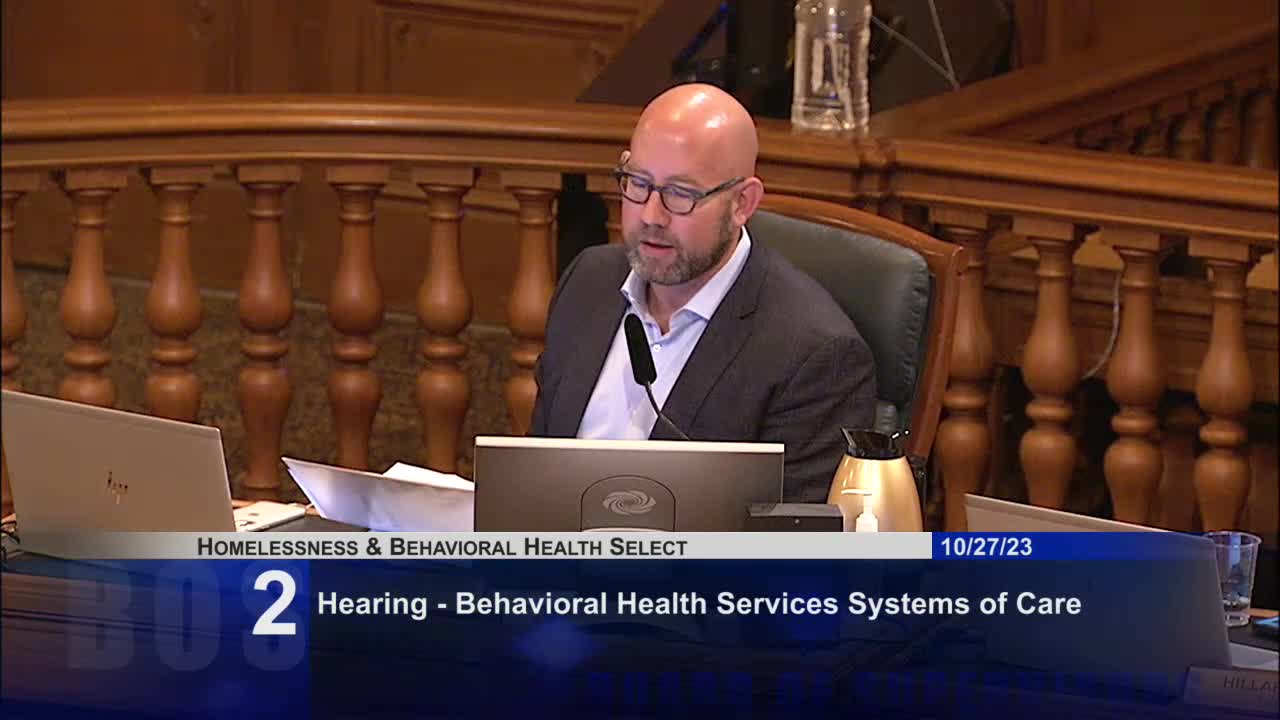San Francisco Health Network officials discuss drug treatment accessibility in county jails
October 27, 2023 | San Francisco County, California
This article was created by AI summarizing key points discussed. AI makes mistakes, so for full details and context, please refer to the video of the full meeting. Please report any errors so we can fix them. Report an error »

In a recent San Francisco County government meeting, officials engaged in a critical discussion regarding the accessibility and effectiveness of behavioral health services for individuals in custody. The meeting highlighted significant concerns about the delivery of drug treatment and mental health services within the county jail system, emphasizing the need for a more systematic approach to reach those in need.
Dr. Hallie Hammer, director of ambulatory care for the San Francisco Health Network, addressed the complexities of providing meaningful treatment to incarcerated individuals. She noted that while the jail health team is dedicated to offering support, the challenge lies in effectively engaging individuals who may not recognize the benefits of treatment. The conversation underscored the importance of timing and persistence in outreach efforts, as many individuals may initially reject assistance.
A key point raised during the meeting was the alarming rate of overdose deaths among individuals released from jail. Officials acknowledged that many individuals experience heightened sensitivity to substances after detoxification, leading to increased risks upon re-entry into the community. The discussion included the necessity of providing naloxone, a medication that can reverse opioid overdoses, to individuals upon their release to mitigate these risks.
The meeting also touched on staffing challenges within jail health services, with a reported vacancy rate of 35-40% among behavioral health staff. This shortage complicates the delivery of care and raises questions about recruitment and retention strategies. Officials indicated ongoing discussions with human resources to explore potential incentives for attracting and retaining qualified staff.
Moreover, the conversation revealed a broader issue regarding the treatment of individuals deemed incompetent to stand trial. Many of these individuals remain in jail due to a lack of appropriate mental health facilities, highlighting a systemic gap in care. Officials expressed the need for a comprehensive beds optimization study to better understand the demand for treatment facilities and to address the needs of this vulnerable population.
In conclusion, the meeting illuminated the pressing challenges facing San Francisco's behavioral health services, particularly within the jail system. As officials prepare for future discussions on treatment on demand, there is a clear call for a more structured and quantifiable approach to identify gaps in service delivery and improve outcomes for individuals in custody. The anticipated beds optimization study may provide critical insights into addressing these ongoing issues and enhancing the overall effectiveness of the county's health services.
Dr. Hallie Hammer, director of ambulatory care for the San Francisco Health Network, addressed the complexities of providing meaningful treatment to incarcerated individuals. She noted that while the jail health team is dedicated to offering support, the challenge lies in effectively engaging individuals who may not recognize the benefits of treatment. The conversation underscored the importance of timing and persistence in outreach efforts, as many individuals may initially reject assistance.
A key point raised during the meeting was the alarming rate of overdose deaths among individuals released from jail. Officials acknowledged that many individuals experience heightened sensitivity to substances after detoxification, leading to increased risks upon re-entry into the community. The discussion included the necessity of providing naloxone, a medication that can reverse opioid overdoses, to individuals upon their release to mitigate these risks.
The meeting also touched on staffing challenges within jail health services, with a reported vacancy rate of 35-40% among behavioral health staff. This shortage complicates the delivery of care and raises questions about recruitment and retention strategies. Officials indicated ongoing discussions with human resources to explore potential incentives for attracting and retaining qualified staff.
Moreover, the conversation revealed a broader issue regarding the treatment of individuals deemed incompetent to stand trial. Many of these individuals remain in jail due to a lack of appropriate mental health facilities, highlighting a systemic gap in care. Officials expressed the need for a comprehensive beds optimization study to better understand the demand for treatment facilities and to address the needs of this vulnerable population.
In conclusion, the meeting illuminated the pressing challenges facing San Francisco's behavioral health services, particularly within the jail system. As officials prepare for future discussions on treatment on demand, there is a clear call for a more structured and quantifiable approach to identify gaps in service delivery and improve outcomes for individuals in custody. The anticipated beds optimization study may provide critical insights into addressing these ongoing issues and enhancing the overall effectiveness of the county's health services.
View the Full Meeting & All Its Details
This article offers just a summary. Unlock complete video, transcripts, and insights as a Founder Member.
✓
Watch full, unedited meeting videos
✓
Search every word spoken in unlimited transcripts
✓
AI summaries & real-time alerts (all government levels)
✓
Permanent access to expanding government content
30-day money-back guarantee

